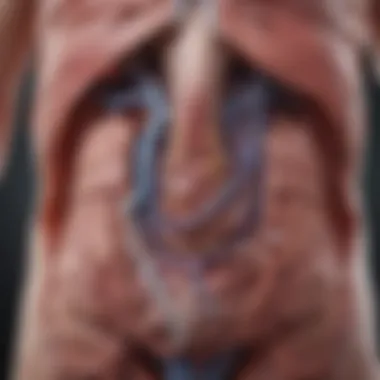Pancreas Function and Enzymatic Role Explained


Intro
The pancreas is a vital organ in the human body, intricately involved in both digestion and metabolic regulation. It fulfills multiple roles that are essential for maintaining overall health. Understanding the pancreas's functions and enzymatic activities is not only important for students and educators but also for researchers and professionals in health sciences.
This analysis aims to clarify how the pancreas operates, focusing on its structure, the types of enzymes it produces, and their specific roles in the digestive process. Additionally, it discusses the hormonal functions of the pancreas, which help regulate blood sugar levels and other metabolic processes. Lastly, the article will address common disorders related to pancreatic dysfunction, providing insights into their implications for general health.
Overview of the Pancreas
The pancreas is a vital organ with a hybrid role in the human body, acting both in the digestive system and in metabolic regulation. Understanding its function is crucial, especially for students, researchers, and professionals in health-related fields. This section provides a foundation by discussing its anatomy and various functions. The insight gained here not only enhances comprehension of digestive and hormonal processes but also informs about potential related disorders.
Anatomy of the Pancreas
Location and Size
The pancreas is situated behind the stomach, spanning approximately six inches in length. Its location allows it to effectively interact with other digestive organs, primarily the small intestine. A key characteristic is its proximity to the duodenum, where it releases digestive enzymes. This anatomical positioning is beneficial as it facilitates the swift delivery of crucial enzymes necessary for digestion, contributing to nutrient absorption efficiency. One notable feature of its size is the ratio of endocrine to exocrine tissue, which plays a significant role in its overall function. The small size of the endocrine portion contrasts with its extensive exocrine system, underlining the importance of each component.
Structural Components
The pancreas comprises both endocrine and exocrine tissues. The exocrine tissue, making up about 95% of the organ, is organized into acini, which are small clusters that secrete digestive juices. The structure of these acini optimizes enzyme production and secretion. This structural aspect is crucial for the efficient digestion of nutrients. Additionally, the islets of Langerhans, the endocrine components, are scattered throughout the pancreas and secrete hormones like insulin and glucagon. The combination of these structural features ensures balanced functioning, reflecting the pancreas's dual roles.
Histological Features
Histologically, the pancreas exhibits distinct differences between its endocrine and exocrine components. The exocrine tissue is rich in cells that produce digestive enzymes, while the endocrine tissue is characterized by clusters of cells known as islets of Langerhans. A hallmark of these islets is their vascularization, which is vital for the rapid transport of hormones into the bloodstream. This histological detail is essential because it highlights how structure supports function. The presence of various cell types within the islets facilitates the regulation of blood sugar levels, showcasing the complex interplay between cellular structures and their physiological roles.
Functions of the Pancreas
Exocrine Function
The exocrine function of the pancreas is primarily to produce and secrete digestive enzymes into the small intestine. This function is vital for breaking down carbohydrates, proteins, and fats into absorbable molecules. A key characteristic of this role is the production of enzymes like amylase, proteases, and lipases. The secretion of these enzymes is initiated by hormonal signals from the gut, demonstrating a well-coordinated digestive process. The unique feature of this function lies in its responsiveness to food intake, which can be seen as an advantage because it ensures that digestive needs are met in real time, optimizing nutrient absorption.
Endocrine Function
The endocrine function of the pancreas involves the secretion of hormones directly into the bloodstream, regulating blood sugar levels and overall metabolism. Insulin and glucagon are the most recognized hormones produced here. A key characteristic of this aspect is the dynamic feedback system that maintains glucose homeostasis. This function is beneficial because it allows for precise control over energy use in the body. The unique capability to respond to varying blood glucose levels highlights the pancreas's importance; failure in this system can lead to serious conditions like diabetes, illustrating the pancreas’s critical role in maintaining metabolic balance.
Exocrine Function and Digestive Enzymes
The exocrine function of the pancreas is pivotal in the digestion of food. This part of the pancreas produces enzymes that are essential for breaking down carbohydrates, proteins, and fats. Without these digestive enzymes, the body would struggle to absorb essential nutrients. The pancreas releases these enzymes into the small intestine, where they play a crucial role in the digestive process.
Production of Digestive Enzymes
Enzyme Synthesis
Enzyme synthesis in the pancreas is a highly coordinated process. Cells called acinar cells are responsible for producing these enzymes. The synthesis involves creating precursor forms of enzymes, known as zymogens. This characteristic is essential because it prevents the enzymes from digesting the pancreas itself before they reach the small intestine. The production of these enzymes is not only critical for digestion but also reflects the pancreas's ability to respond to dietary intake. The unique feature of enzyme synthesis is its capacity to adapt according to food intake. While it is beneficial, if the synthesis mechanisms become impaired, it can lead to digestive disorders.
Storage and Activation
Once synthesized, digestive enzymes are stored in the pancreas until activated. These enzymes are stored in inactive forms to prevent autodigestion. When food enters the small intestine, specific signals trigger their activation. This process ensures that enzymes are only active in the context of digestion and not beforehand, minimizing potential damage to pancreas tissue. While this storage mechanism protects the pancreas, any malfunctions can lead to conditions like pancreatitis, indicating storage and activation are double-edged swords.


Key Digestive Enzymes
Amylase
Amylase is an enzyme that breaks down carbohydrates into simpler sugars. This enzyme is secreted in its active form and works efficiently in the small intestine. Its key characteristic is its ability to initiate carbohydrate digestion shortly after food consumption. Amylase is crucial for optimal nutrient absorption, making it an essential focus of this article. However, its activity can be hindered by certain conditions and improper diet, limiting its effectiveness.
Proteases
Proteases are a group of enzymes that digest proteins into smaller peptides. These enzymes are vital for protein metabolism and absorption. Proteases are secreted as zymogens and activated only in the presence of other digestive enzymes or specific conditions within the intestine. The unique aspect of proteases is their specificity; different proteases target distinct peptide bonds, allowing for efficient protein breakdown. Nevertheless, an overproduction or imbalance of proteases can lead to harmful effects on health, highlighting their importance in digestive health.
Lipase
Lipase is responsible for the digestion of fats, transforming them into fatty acids and glycerol. This enzyme has a key role, especially given the high fat content in many diets. Lipase is secreted in an active form and works best in the presence of bile salts. Its unique feature is the ability to break down triglycerides effectively, facilitating fat absorption in the intestines. However, lipase can be affected by various factors such as the presence of pancreatic disorders, which can decrease its activity and affect fat digestion.
Role of Bicarbonate in Digestion
Bicarbonate Secretion
Bicarbonate secretion by the pancreas is another critical function. This alkaline solution neutralizes gastric acid entering the small intestine, creating an optimal environment for digestive enzymes to function. The characteristic of bicarbonate secretion is its ability to buffer pH levels, ensuring enzymes can operate without denaturation. It is a necessary and beneficial choice for digestive health. However, if there is insufficient bicarbonate, it can lead to digestive discomfort and poor nutrient absorption.
Neutralization of Gastric Acid
Neutralization of gastric acid is essential for protecting the intestinal lining and facilitating digestion. Bicarbonate plays a direct role in this process, as it raises pH levels in the small intestine. This feature is vital, ensuring that enzymes remain functional in their optimal pH range. The blanket of neutralization prevents damage from high acidity but can become problematic in cases where the bicarbonate response is inadequate or overactive, potentially leading to metabolic issues.
Endocrine Function and Hormones
The endocrine function of the pancreas is vital to understanding how this organ contributes to the regulation of metabolism. Hormones secreted by the pancreas play a significant role in maintaining blood sugar levels and metabolic balance. This section outlines the primary hormones produced by the pancreas, their functions, and the mechanisms that regulate blood sugar.
Hormones Produced by the Pancreas
Insulin
Insulin is arguably the most recognized hormone produced by the pancreas. It is integral for lowering blood sugar levels. After eating, blood glucose levels rise, triggering the pancreas to release insulin. The primary role of insulin is to facilitate the uptake of glucose into cells, allowing for its use as energy or storage as glycogen.
The key characteristic of insulin is its ability to lower blood sugar quickly. This rapid response makes it crucial for individuals with diabetes, who may have irregular insulin production or action. Insulin can be administered in various forms, including syringes, pens, or pumps. The significant advantage of insulin is its life-saving capacity for those with type 1 diabetes or advanced type 2 diabetes who cannot produce sufficient amounts.
However, there are disadvantages associated with insulin therapy. It requires careful dosage management to avoid hypoglycemia, a condition where blood sugar levels drop too low. Moreover, long-term reliance on external insulin can lead to complications.
Glucagon
Glucagon serves as a counter-regulatory hormone to insulin. Produced by the alpha cells of the pancreas, it increases blood sugar levels when they fall too low. This hormone is released in response to low blood glucose levels, stimulating the liver to convert glycogen back to glucose, thereby elevating blood sugar.
The key characteristic of glucagon is its rapid action in response to hypoglycemia. This hormone is beneficial for those who have episodes of low blood sugar. It can be administered through an injection when someone shows signs of severe hypoglycemia. Its unique feature lies in its ability to act quickly, providing an essential physiological counterbalance to insulin.
However, glucagon is less commonly used compared to insulin, limiting its visibility. Also, while it effectively raises blood sugar, it does not lower it, which presents a risk for those who mismanage both hormones.
Somatostatin


Somatostatin plays a regulatory role in the pancreas. It inhibits the secretion of both insulin and glucagon, serving as a balance in hormone production. This regulation keeps blood sugar levels within a stable range. By preventing excessive hormone release, somatostatin helps maintain metabolic homeostasis.
A key characteristic of somatostatin is its ability to modulate other hormonal activities. It acts as a significant endogenous inhibitor, reducing the activity of a spectrum of hormones and slowing the digestive process. This can be advantageous in preventing hyperinsulinism, which can occur from excessive insulin release.
Somatostatin can be helpful in certain medical conditions, such as acromegaly, where hormone overproduction occurs. However, somatostatin's inhibitory nature may become a disadvantage in terms of necessary metabolic responses, as excessive inhibition can lead to problems in managing blood glucose levels effectively.
Regulation of Blood Sugar Levels
Feedback Mechanisms
The regulation of blood sugar levels primarily relies on feedback mechanisms facilitated by the pancreas. When blood sugar rises, insulin is released. This promotes cellular glucose uptake, reducing blood sugar levels. Conversely, when blood sugar falls, glucagon is secreted to stimulate glucose production in the liver. This system of checks and balances ensures that blood sugar remains within a normal range, crucial for metabolic homeostasis.
The simplicity of feedback mechanisms makes them a foundational aspect of hormonal regulation. They provide a reliable and efficient way to manage changes in blood sugar levels. The specific nature of these mechanisms means they respond quickly to even slight variations in blood sugar, enhancing their functional relevance.
However, this system may fail in certain disorders, leading to the complications observed in diabetes and other metabolic diseases.
Interaction with Other Hormones
Blood sugar regulation does not occur in isolation. The interaction between insulin, glucagon, and other hormones like cortisol and adrenaline is essential. For example, cortisol can raise blood sugar levels during stress, acting against the effects of insulin. Understanding these interactions is necessary to fully appreciate how the body maintains homeostasis.
The unique aspect of these interactions lies in their collective influence on metabolism. While each hormone plays its role, they do not work alone; their interdependencies can complicate conditions like diabetes.
Dysfunction of the Pancreas
The dysfunction of the pancreas is a critical issue that affects both digestive and metabolic health. This section delves into the various disorders that can arise from pancreatic dysfunction, exploring how these conditions can disrupt normal bodily functions. Understanding these disorders is essential for recognizing symptoms, seeking appropriate treatments, and undergoing preventive measures.
Common Pancreatic Disorders
Pancreatitis
Pancreatitis is characterized by inflammation of the pancreas. It can be acute or chronic, each type presenting unique challenges. Acute pancreatitis occurs suddenly and may resolve with treatment, while chronic pancreatitis develops over time and may lead to lasting damage. A key characteristic of pancreatitis is abdominal pain, which can range from mild to severe. This makes it an important choice for discussion in this article, as it highlights the immediate implications of pancreatic dysfunction.
A unique feature of pancreatitis is its link to lifestyle choices, such as alcohol consumption and diet. These factors can lead to recurring episodes, which pose both advantages and disadvantages. On the one hand, recognizing these links can aid in prevention strategies. On the other hand, chronic pancreatitis can result in long-term health issues, including digestive problems and diabetes.
Diabetes Mellitus
Diabetes mellitus involves the body's inability to properly regulate blood sugar levels, often linked to insulin secretion issues from the pancreas. A pivotal aspect of diabetes is that it demonstrates the endocrine function of the pancreas. It is included in this article due to its widespread impact on health. This condition affects millions globally, leading to both acute and chronic complications.
The unique feature of diabetes mellitus is how it necessitates lifestyle adjustments and, frequently, ongoing medical management. The disease's chronic nature can lead to severe complications, including cardiovascular issues, making it essential to understand. Thus, the implications of diabetes mellitus within this discourse are profound.
Pancreatic Cancer
Pancreatic cancer is one of the most serious conditions associated with pancreatic dysfunction. It is often diagnosed late, which contributes to its high mortality rate. The key characteristic of this cancer is its rapid progression and resistance to standard treatments, which underscores its significance in this article.
A unique feature of pancreatic cancer is the complexity in its early symptoms, often mistaken for less severe conditions. Recognizing these symptoms early can drastically change outcomes, making education on this topic necessary. The limited available treatment options pose significant challenges for patients and healthcare professionals alike. Understanding the aggressive nature of this cancer may help in advocating for early screening and research funding, thus combating this devastating disease.
Impact of Pancreatic Disorders on Health


Symptoms and Diagnosis
The symptoms of pancreatic disorders can vary widely, often leading to misdiagnoses or delayed treatments. Abdominal pain, weight loss, and digestive issues are common indicators, contributing to their significance in this article.
A key characteristic of the symptoms is that they can overlap with other gastrointestinal conditions, complicating the diagnostic process. This is vital for readers to understand as it stresses the importance of comprehensive medical evaluation. Diagnosing pancreatic disorders may require imaging studies or blood tests, which have unique features that aid in accurately identifying underlying issues. The complexity of these diagnostic processes can have both advantages, in terms of thoroughness, and disadvantages, including potential delays in treatment.
Treatment Options
Treatment options for pancreatic disorders depend on the specific condition presented. For example, pancreatitis may require hospitalization and management of pain, while diabetes management could involve insulin therapy or dietary changes. Understanding these options is crucial for individuals affected by pancreatic disorders, emphasizing the importance of this topic in our article.
The key characteristic of treatment options is their specificity to each disorder, underscoring that one-size-fits-all solutions are ineffective. A unique feature of the treatment landscape for pancreatic disorders is the ongoing research into novel therapies, which presents both hope and challenges. The advantages include emerging treatment possibilities, while the disadvantages involve accessibility and variability in effectiveness. Ultimately, a deeper understanding of these treatment options can empower patients and inform healthcare providers as they navigate the complexities of pancreatic health.
Importance of the Pancreas in Overall Health
The pancreas serves an essential function in maintaining overall health. This gland is not only involved in digestion but also plays a critical role in metabolic regulation. By producing digestive enzymes and hormones, the pancreas significantly influences nutrient absorption and blood sugar levels, crucial for maintaining homeostasis in the body.
A healthy pancreas means the body can efficiently digest food and manage energy. When functioning correctly, this organ promotes proper nutrient absorption, enables effective metabolism, and prevents diseases. The connection between the pancreas and overall well-being underlines the necessity of maintaining its health through lifestyle choices and awareness of potential disorders.
Additionally, understanding the pancreas's role aids in grasping how various lifestyle and dietary factors can affect its function and, by extension, overall health. This knowledge is essential in fostering awareness around preventive measures and treatments related to pancreatic dysfunction.
Role in Nutrition and Metabolism
Nutrient Absorption
Nutrient absorption is vital for energy and health. The pancreas contributes to this process by secreting enzymes that break down fats, proteins, and carbohydrates. These digestive enzymes ensure that nutrients are accessible to the body. A key characteristic of nutrient absorption is that it allows the body to utilize the energy stored in food.
The unique feature of nutrient absorption is its impact on overall health. By ensuring that essential vitamins and minerals are absorbed effectively, it promotes not only physical health but also functions critical for cellular processes.
Some disadvantages may arise if the pancreas underperforms. Low enzyme production can lead to nutritional deficiencies, as food may not be adequately digested. This scenario may highlight the importance of maintaining pancreatic health.
Metabolic Pathways
Metabolic pathways dictate how the body uses energy. The pancreas plays a significant role in regulating these pathways through hormone secretion. Insulin and glucagon are two primary hormones that affect how glucose is metabolized. One important aspect of metabolic pathways is that they help adapt to varying energy needs.
The unique feature of metabolic pathways is their responsiveness to dietary changes. For instance, consuming high-carbohydrate meals stimulates significant insulin release, enhancing glucose uptake. However, if the pancreas becomes dysfunctional, as in diabetes, these pathways can falter.
Understanding these pathways provides insight into managing energy levels effectively, illustrating the pancreas's relevance in metabolic health.
Pancreas and Disease Prevention
Lifestyle Factors
Lifestyle factors like diet, physical activity, and weight management directly affect pancreatic health. Healthy eating habits, such as consuming a balanced diet rich in whole foods, can support pancreatic function. An essential characteristic of lifestyle factors is their role in reducing the risk of pancreatic disorders, including diabetes and pancreatic cancer.
The unique aspect of lifestyle changes is that they can be preventative. Adopting a healthier lifestyle can significantly lower the risk of developing conditions that impair the pancreas. Neglecting these factors, however, could increase the likelihood of various health challenges.
Preventative Measures
Preventative measures encompass regular medical check-ups, maintaining a healthy diet, and managing stress levels. By proactively addressing these aspects, individuals can keep their pancreas functioning optimally. One key characteristic of preventative measures is that they promote early detection of issues.
The unique feature of preventative measures lies in their straightforward application. Simple lifestyle changes can dramatically improve pancreatic health. However, neglecting these practices might lead to severe health implications, making awareness critical.
In summary, the pancreas's importance in nutrition, metabolism, and disease prevention cannot be overstated. A thorough understanding of its roles encourages healthier lifestyles and better management of health.



